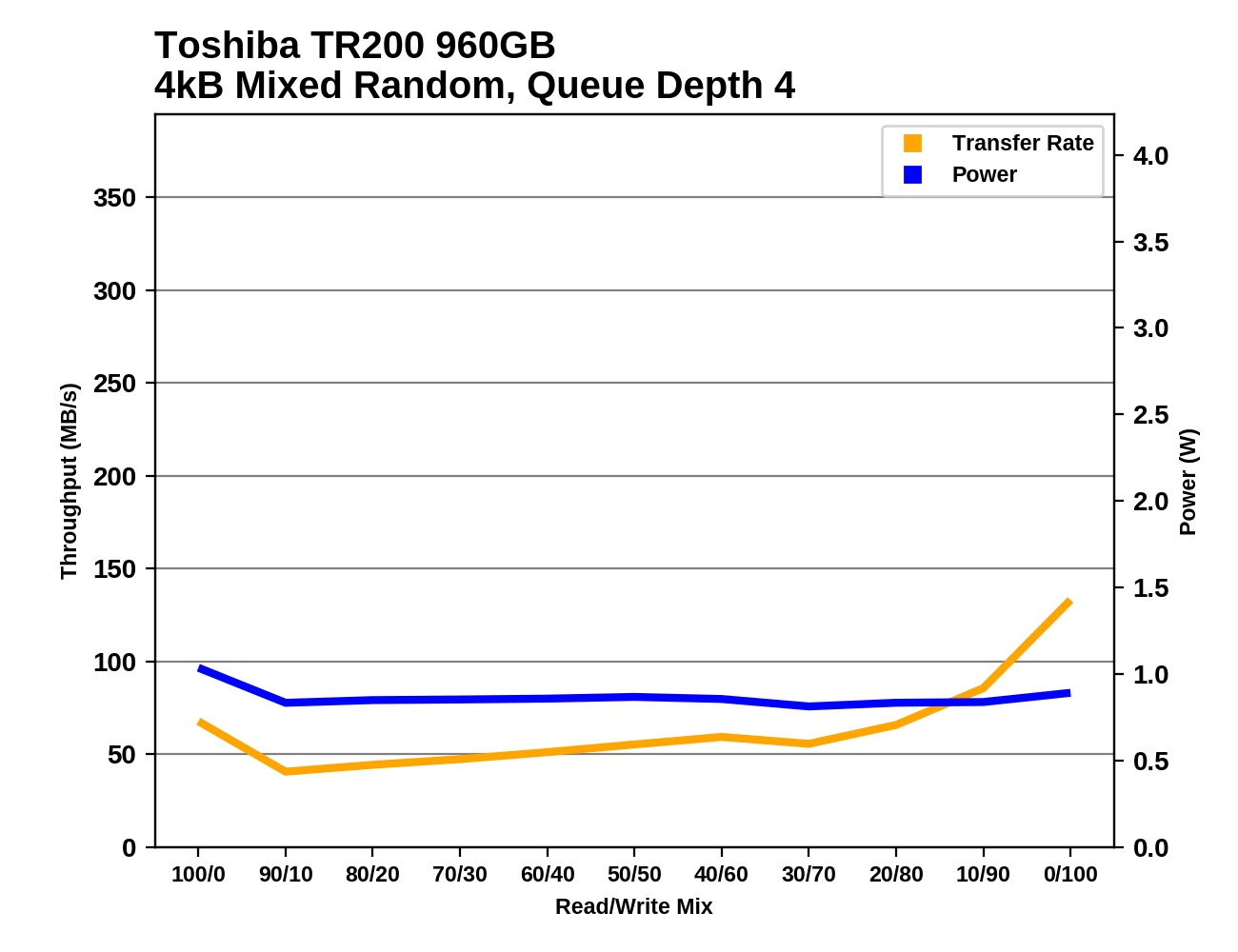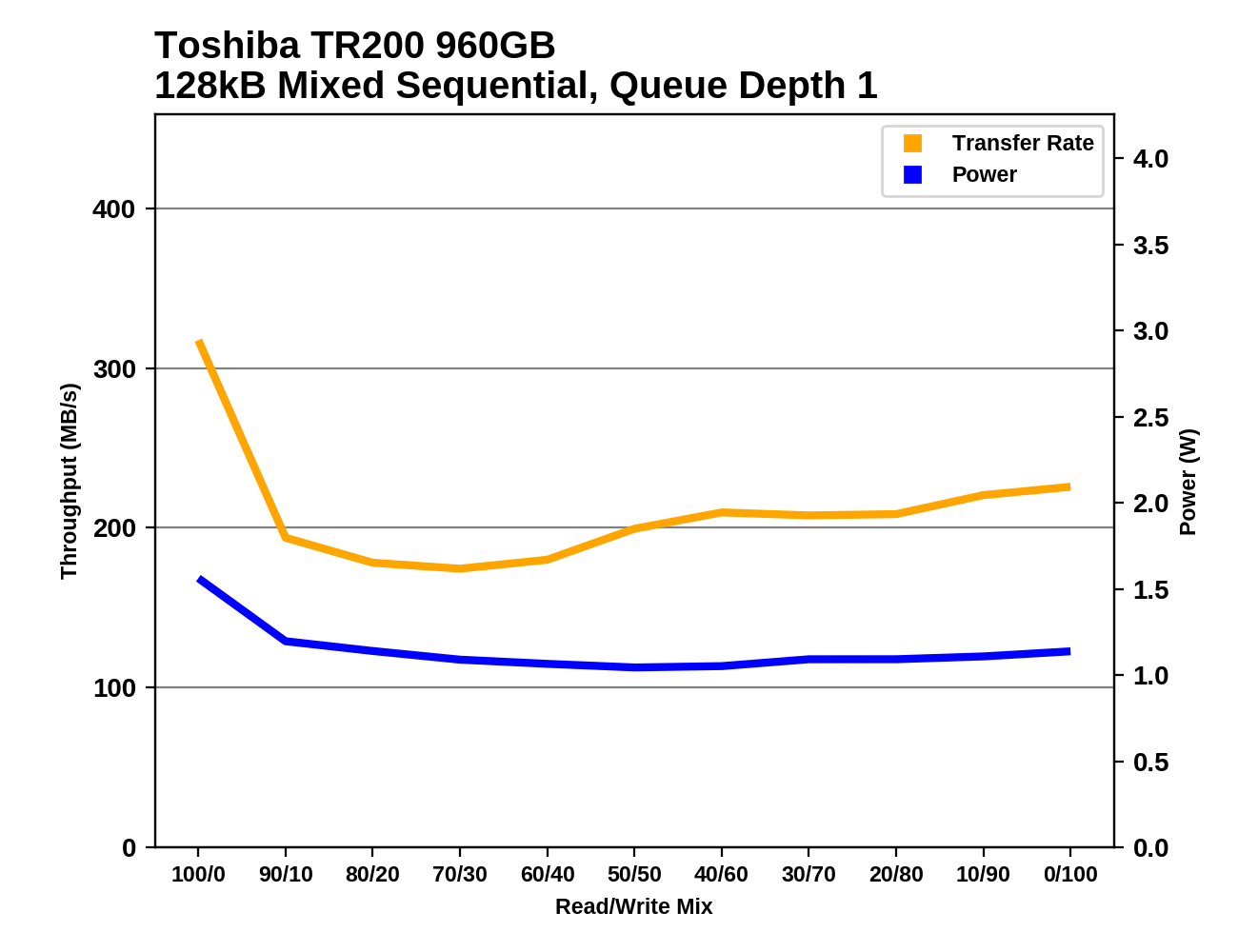The Toshiba TR200 3D NAND SSD Review: One Step Forward, One Step Back
by Billy Tallis on October 11, 2017 7:00 AM ESTMixed Random Performance
Our test of mixed random reads and writes covers mixes varying from pure reads to pure writes at 10% increments. Each mix is tested for up to 1 minute or 32GB of data transferred. The test is conducted with a queue depth of 4, and is limited to a 64GB span of the drive. In between each mix, the drive is given idle time of up to one minute so that the overall duty cycle is 50%.

The mixed random I/O performance of the Toshiba TR200 is much faster than the HP S700, but is slower than everything else, even the earlier Trion/TR series drives. Contemporary budget SSDs like the ADATA SU800 and Crucial MX300 are more than twice as fast.

The power efficiency of the TR200 during the mixed random I/O test is a marked improvement over the TR150 and is more than twice that of the HP S700, but that's not enough for the TR200 to rate much better than acceptable.
 |
|||||||||
The performance of the TR200 during the mixed random I/O test traces out a common bathtub curve shape, with performance dropping after the initial pure reads phase and climbing very slowly as the proportion of writes increases, before accelerating near the end of the test as the workload shifts to mostly writes. The TR200s don't show a large spike in performance at the very end of the test like the TR150 does, but at least they don't bottom out anywhere near as low as the HP S700.
Mixed Sequential Performance
Our test of mixed sequential reads and writes differs from the mixed random I/O test by performing 128kB sequential accesses rather than 4kB accesses at random locations, and the sequential test is conducted at queue depth 1. The range of mixes tested is the same, and the timing and limits on data transfers are also the same as above.

The larger two Toshiba TR200 models are marginally faster than their TR150 predecessors on the mixed sequential I/O test, but the 240GB has lost more than 12% of its overall performance. All of the TR/Trion series drives remain at the bottom of the chart, well below even the other DRAMless SSDs.

The TR200 climbs out of last place for power efficiency, and the 960GB model in particular is near the top of the chart along with the other DRAMless SSDs. The smaller two capacities have fairly average efficiency.
 |
|||||||||
All three of the TR200 models lose a lot of performance when writes are first added to the workload, but they regain a bit of performance through the first half of the test. The 960GB model gains a bit more performance in the second half of the test while the smaller models drop off again. The drives that do well on this test mostly either regain significant performance in the second half, or show steady increases across the entire test.










50 Comments
View All Comments
DanNeely - Wednesday, October 11, 2017 - link
in other news the SATA3 bottleneck is still the SATA3 bottleneck.Faster drives are all PCIe based, so the odds of a SATA4 bumping it up again anytime soon are remote; especially since the SATA API/etc are a poor fit for SSDs and hurt performance a bit. If spinning rust remains relevant long enough for SATA to bottleneck again we might see a new standard revision in a few years; but by then the consumer SSD market will probably be all sticks.
Lord of the Bored - Thursday, October 12, 2017 - link
I honestly can't see hard disks going away completely any time soon. They're still much slower than flash, but flash isn't going to challenge them on the price per byte angle any time soon. 'S why I'm not pure silicon: I have an actual disk for data storage(particularly video files).The price advantage ALSO keeps them shipping in laptops, but the things going into lower-end laptops aren't exactly winning any races.
That said, the pressure for faster hard disks has definitely let up in the years since the first solid-state drives shipped. People trust a lot more of their data to remote servers than they did back then.
The main thing driving capacity increases at this point is commercial users(all that server-side storage moves the demands out of the home), so I don't see SATA3 being a hard disk bottleneck any time soon either. SAS may need an update at some point, though.
dave_the_nerd - Wednesday, October 11, 2017 - link
That's the SATA3 bottleneck. If you want faster, you get a PCI-E drive.sonny73n - Thursday, October 12, 2017 - link
PCI-E will be the bottleneck soon in the future. For now, SATA3 serve me just fine. They don't slow my gaming or anything. Unless I transfer back and forth 10TB of my videos collection from one SATA3 drive to another every day, I don't see a reason to waste my money on soon-to-be obsolete tech.Billy Tallis - Thursday, October 12, 2017 - link
Having drives that can saturate a PCIe link doesn't mean that the PCIe link will be a meaningful bottleneck. We're getting to the point where latency matters far more than throughput (ie. flash vs. 3D XPoint), and aside from that, storage is usually less of a bottleneck than CPU and network and other components.jabber - Friday, October 13, 2017 - link
Indeed, the effect of a 200MB bit of software loading up on a 550 MBps SATA SSD and a 3000MBps NVME SSD are to all intents, identical to the human eye. Never has the promise of a 6 times jump in performance actually given so little.dromoxen - Tuesday, October 17, 2017 - link
550/540 IS the max of SATA 3 ssds .. the rest is lost in overhead and inefficiencys. Just like usb2 vs usb3 should be ten times faster , best I've ever got is 4x faster.heavy soil - Wednesday, October 11, 2017 - link
The speed limit is SATA, the only way to be faster is PCIe (or I guess SAS).What has improved on the good SATA SSDs is the speed they deal with big queues, and coping with heavy writing too.
rocky12345 - Wednesday, October 11, 2017 - link
Thanks for the look at the drive.So this is what dram less drives perform like? All I got to say is ouch those were some bad numbers from this drive. I have the Samsung EVO 850 Pro 512GB Sata drive still and my drive walks circles around this drive in every aspect. Yes my drive cost me a bit more but I have had it for like 2 years now and I am sure the cost of my drive has come down close to what this Toshiba drive now costs. If dram less drives perform like this then the cost to buy into them should be a lot lower than the higher end drives cost. Thanks again for the review your testing here is not flawed but this drive sure is.
Janis2017 - Wednesday, October 11, 2017 - link
That was stupid to give away 90 euro for product who only works 10 years 750evoI hope samsung firmware is ok. I dont need write protected drive.
I dont haw money for one more.